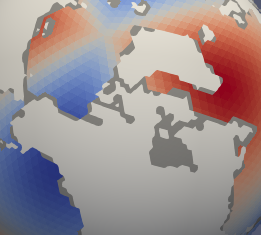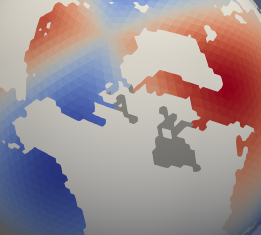Table of Contents
Description
This method supports target fields that are defined on points at the grid corners or cells.
Creep fill is an extrapolation method described in Kara, A. Birol, Alan J. Wallcraft, and Harley E. Hurlburt. " A Correction for Land Contamination of Atmospheric Variables near Land–Sea Boundaries". Journal of Physical Oceanography 37.4 (2007): 803-818. The implementation in YAC is similar to this. For all unmapped target points the method will check the interpolation status of its neighboring target points. If successfully interpolated neighbor points are available, the respective unmapped point will be interpolated based on their results. This check will be repeated until all target points are interpolated or a specified number of iterations of the algorithm is reached.
In the following example a source field with a land mask (grey cells are masked ones) is interpolated to a finer ocean grid missing the land cells. A 1st order conservative interpolation is being used.

The target field as a number of non-interpolated cells (grey cells) that occure due to mismatches between the source mask and the the target ocean grid. The creep fill interpolation method is one option to fill these cells.

Options
Creep distance (default:
creep_distance: -1)Valid range: -1 <= creep_distance
Is the number of interations for the creep fill algorithm. A creep distance of -1 signals the interpolation to execute the algorithm until no additional target points can be interpolated by this method.
Target field with additional creep fill interpolation (grey cell are not being interpolated) creep_distance = 0 creep_distance = 1 creep_distance = 2 creep_distance = 4 



creep_distance = 8 creep_distance = 16 creep_distance = 32 creep_distance = -1 



Creep fill vs. 1NNN
Another method to fill the missing target cells in the example would have been N-Nearest-Neighbour interpolation.
However, this method does not take grid connectivity into account, which leads to obvious differences in the interpolation result.
